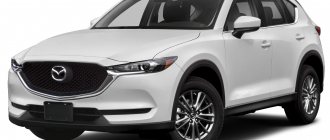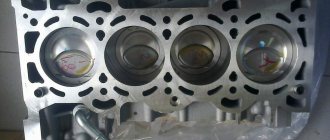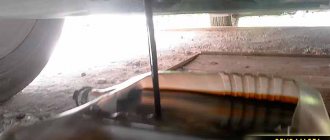Where is Mazda assembled?
The Japanese company Mazda Motor Corporation has been manufacturing cars since 1960 . Mazda 3 and 6 series models are in demand among Russian consumers.
Mazda production is established in various countries around the world. The largest factories are located on the territory of the Japanese state. These include :
- Ujima - the first Mazda company, which is located in the city of Hiroshima. Production workshops occupy two districts of the city.
- Hofu - the second enterprise of the Mazda concern, which operating since 1982. Mazda models are assembled on it.
- Miyoshi (Miyoshi) - conveyor lines in the workshops are set up for the production of internal combustion engines for various cars.
Mazda is also assembled in the following countries : South Africa, Vietnam, Zimbabwe, Mexico, Malaysia, China, Colombia, Ecuador, USA, Taiwan, Thailand and Russia.
Since the end of 2005, the Japanese company has been represented in the Russian Federation by the wholesale buyer Mazda Motor Rus . It is a subsidiary of the parent company Mazda Motor Corporation. The basic production facilities through which Mazda is assembled are located in Vladivostok. They launched in October 2012 , thanks to a partnership agreement between Mazda and the domestic organization Sollers. The plant is called MAZDA SOLLERS Manufacturing Rus .
MSMR plant for the assembly of Mazda cars in Russia.
Characteristics of Mazda 6 for the Russian market
Sixes for the Russian market are offered only in a sedan body. Technical equipment - two petrol engines Skyactiv-G 2.0 165 hp, 210 Nm and Skyactiv-G 2.5 192 hp, 256 Nm.
All modifications of the Mazda 6 come exclusively with a 6AT hydromechanical automatic transmission and front-wheel drive. Brakes are disc brakes on all wheels, with ventilation at the front. The suspension on the front axle is MacPherson struts with upgraded springs and shock absorbers, the rear axle is multi-link with reinforced mounting of the rear trailing arms. The electric power steering mechanism is rigidly mounted on a subframe.
In 2021, where the Mazda 6 is assembled, they plan to increase production by 10% compared to the previous period.
Mazda 6 sedan car
Mazda 6 (due to restrictions on the use of numbers in car brands, the combined spelling Mazda6 is used) is a mid-size car from the Japanese company Mazda. Produced since 2002. In Japan and China it is sold under the name Mazda Atenza.
The predecessor of the model is considered to be the Mazda 626, also known as the Mazda Capella. The first generation Mazda 6 became the first representative of Mazda's new model range. It was followed by the Mazda 2 in December 2002, the RX-8 in August 2003, the Mazda 3 in January 2004, and the Mazda 5 in the summer of 2005.
Mazda 6 history
1st generation, 2002–2008
In 2002, production of the new Mazda 6 began in Japan, replacing the 626 model. This car was known locally as the Atenza. Buyers were offered one of three body types: sedan, hatchback or station wagon.
On the Russian market, the Mazda 6 was offered with petrol engines 1.8 (120 hp), 2.0 (141 hp) and 2.3 with a capacity of 166 hp. With. Transmissions: five-speed manual or four-speed automatic. In Europe there were also versions with a two-liter turbodiesel engine developing 120, 136 or 143 hp. With. depending on the modification, and in North America a Mazda 6 with a three-liter V6 engine (218 hp) was also offered
Restyling in 2005 practically did not affect the exterior of the car, but the interior trim was improved. The two-liter power unit received a variable valve timing system and became slightly more powerful - 147 hp. With. The manual transmission has become six-speed (on versions 2.0 and 2.3), and the automatic has become five-speed. Later, deliveries to the Russian market of station wagons with a 2.3-liter engine and all-wheel drive began.
A special place in the lineup was occupied by the “charged” sedan Mazda 6 MPS (in America it was called Mazdaspeed 6) of the 2004 model. It was equipped with a turbocharged 2.3-liter engine with direct fuel injection that developed 260 hp. s., all-wheel drive system and manual transmission.
In Japan, production of the car ended in 2008, but in China this model is still produced at the FAW-Mazda joint venture. Cars for the local market are equipped with two-liter engines with a capacity of 145 hp. With.
2nd generation, 2008–2012
In 2008, the second generation Mazda 6 was introduced. The car has slightly increased in size, but at the same time has become several tens of kilograms lighter. The range of body types remains the same - sedan, hatchback and station wagon.
Mazda 6 was equipped with four-cylinder gasoline engines 1.8 (120 hp), 2.0 (147 hp) and 2.5 with a capacity of 170 hp. With. In European countries, versions with turbodiesels of two liters (140 hp) or 2.2 liters (125–185 hp) were also offered, but diesel cars were not supplied to Russia. A six-speed automatic transmission was offered as an option for cars with 2.0 and 2.5 petrol engines. Only a sedan was available on the American market, and it differed from the European car in its wheelbase extended by 6 cm. This Mazda 6 was offered with a 2.5 engine, as well as a V-shaped “six” with a volume of 3.7 liters and a power of 276 hp. With.
In 2010, the two-liter gasoline engine was modernized and received direct fuel injection, and its output increased to 155 hp. s., but the previous version of the power unit remains on sale on the Russian market. In the same year, Mazda 6 received a slightly updated design. This model is still produced in China.
Restyling 2010
In 2010, an updated version of the Mazda6 was released. Its premiere took place at the international auto show in Geneva. The model year of the restyled car is stated as 2011. Externally, the car differs only in the new radiator grille, front bumper, head and rear optics. The interior of the updated Mazda6 has new front seats and higher quality plastics, and the display of information on the display in the instrument panel and on-board computer monitor has changed. The base of the car body was made more rigid, the electric power steering received a new control unit, and a number of changes were made to the suspension, which had a positive effect on comfort. In addition to the manual transmission, the 2.5-liter engine was also offered with an automatic transmission. The 2-liter gasoline engine became more powerful and dynamic due to the use of direct fuel injection, however, in a number of markets, including Russian, such a power unit was not available. Also, Mazda6 versions with diesel power units were not supplied to Russia. Sales of the updated Mazda6 in Russia started at the end of March 2010.
3rd generation, 2012
The third generation of the Mazda 6 has been produced since 2012 in Japan; in 2013, the assembly of sedans for the Russian market began in Vladivostok. Versions with diesel engines and station wagon bodies are not supplied to us. In 2021, sales of the updated Mazda 6 sedans began.
- Mazda 6 2.0. The price of a car with a two-liter engine (150 hp) in the Drive configuration is 1,324,000 rubles. It is equipped with six airbags, air conditioning, audio system, heated front seats, and alloy wheels. The Active version (dual-zone climate control, cruise control, light and rain sensors) is priced at 1,385,000 rubles, and the Mazda 6 in the Supreme version (leather interior, electrically adjustable driver's seat, heated rear seats, keyless entry system, parking sensors, heated steering wheel, LED headlights) costs 1,606,500 rubles.
- Mazda 6 2.5. A sedan equipped with a 2.5-liter engine producing 192 hp. pp., is offered in Active trim levels for 1,495,000 rubles, Supreme for 1,716,500 rubles. The price of the most expensive version of the model is 1,877,200 rubles; it is equipped with a sunroof, a rear view camera, improved interior trim, and a Bose audio system.
Where is Mazda 6 produced for Russia?
Mazda 6 assembly process in Vladivostok
The production of the spacious family Mazda 6 started in 2002 . Over the past three generations . The developers paid special attention to the bold style and insightful designer. The predecessor of the model was the Mazda 626 (Capella) , which replaced the 616 series.
Mazda 626 Capella predecessor of the Six
Until 2012, Mazda 6 was supplied to Russia from the city of Hiroshima, where they are produced on Ujima conveyor belts. Subsequently, deliveries were made from Vladivostok, where the Mazda 6 sedan and other models are assembled at the MSMR . The following complaints have been made regarding the quality of Russian assembly:
- Now it is practically impossible to purchase an updated version of the Mazda sixth series, which was assembled in Japanese factories, in Russia.
Manufacturing Rus in Vladivostok.
Mazda 6 Sedan: review
Peculiarities
Stylish appearance and thoughtful interior allow you not only to move in comfort, but also not to blend in with the general flow on the road. The seats are comfortable for the driver and passengers, in particular, there is noticeably more space in the rear due to the increased dimensions (4865*1460*2830 mm). Two engine options are available - a 2-liter gasoline engine with a power of 150 “horses” as the base one, as well as a more powerful variation of 2.5 liters and 192 hp. Manual or automatic transmission, 6 gears. In addition, a unique braking energy recovery system has been added.
Sound insulation has been improved thanks to optimization of the sound-absorbing material of the instrument panel, the material in the roof lining, improved door seals, additional vibration-proofing material has been added to the trunk floor lining, the protective and sound-absorbing properties of the sills have been increased, and a bottom seal has been added. In general, from the point of view of acoustic comfort, the Mazda 6 has really moved up to the premium segment!
The updated Mazda 6 is distinguished not only by more beautiful headlights with a new design at night, but also by their filling with adaptive LED headlights. Moreover, the LEDs are divided into four groups, the brightness of each of which is controlled individually, allowing you to avoid blinding oncoming drivers. And thanks to three low-beam LEDs, the illumination area at close range is increased. The vertical optical axis is controlled depending on the vehicle speed by a compact stepper motor located in the headlight housing.
A new system has appeared for monitoring the position of the car in relation to road markings LKA (Lane Keep Assist), which, using cameras, determines the position of the car and can correct it by changing the force on the steering wheel in the desired direction. Another thing is that with our markup this innovative function is often ineffective and you definitely shouldn’t rely on it. But in the event of an unauthorized departure from the lane, it can wake up a tired driver at a critical moment with a buzzer or vibration on the steering wheel.
Options
Already in the basic configuration there are all the necessary safety systems: ABS, six airbags, stability control (DSC), brake force distribution (EBD), emergency braking assist (EBA), traction control system (TCS), pressure control system Tire Management System (TPMS), Hill Lash Anti-Roll Assist (HLA) and City Safety Braking System (SCBS).
In the top version of the Premium Mazda 6 Diesel, it has active cruise control that maintains a specified distance to the front vehicle. Also included in the top-of-the-line range are ALH (LED Adaptive Headlights), SBS (Highway Brake Assist), LDWS (Lane Departure Warning System), LKA (Lane Assist), RCTA (Rear Cross Traffic Alert). , BSM (blind spot monitoring system).
Technical specifications
From 2002 to 2007
| Length 4680 mm | Width 1780 mm |
| Height 1435 mm | Weight 1305 kg |
| Number of speeds 5 | 6.43 l/100 km |
| 4 EURO | CO2 emissions 184 g/km |
| Engine capacity 1798 cm3 | Number of cylinders 4 |
| Acceleration from 0 to 100 km/h 10.7 sec. | Maximum speed 196 km/h |
| Engine power 120 hp | Number of valves 16 |
| Torque 165 Nm | Wheelbase 2675 mm |
| Minimum trunk volume 501 liters. | Fuel tank volume 64 l. |
From 2007 to 2009
| Length 4755 mm | Width 1795 mm |
| Height 1440 mm | Weight 1520 kg |
| Number of speeds 6 | Fuel consumption (mixed mode) 4.59 l/100 km |
| European exhaust gas standard 4 EURO | CO2 emissions 147 g/km |
| Engine capacity 2183 cm 3 | Number of cylinders 4 |
| Acceleration from 0 to 100 km/h 8.9 sec. | Maximum speed 212 km/h |
| Engine power 163 hp | Number of valves 16 |
| Torque 360 Nm | Wheelbase 2725 mm |
| Minimum trunk volume 519 liters. | Fuel tank volume 64 l. |
From 2013 to present
| Length 4870 mm | Width 1840 mm |
| Height 1450 mm | Number of speeds 6 |
| Fuel consumption (mixed mode) 5 l/100 km | European exhaust gas standard 5 EURO |
| CO2 emissions 129 g/km | Engine capacity 1998 cm 3 |
| Number of cylinders 4 | Acceleration from 0 to 100 km/h 9.2 sec. |
| Maximum speed 208 km/h | Engine power 142 hp |
| Number of valves 16 | Wheelbase 2830 mm |
| Minimum trunk volume 483 liters. | Fuel tank volume 62 l. |
Determining the country of assembly by VIN
Decoding the vin code of the CX-5
According to established requirements, each manufacturer is required to apply a VIN number . It is a combination of letters and numbers , which carries information about the car, technical characteristics, and equipment. The number is duplicated in the following places :
- in the central part of the motor space;
- on the doorway pillar;
- in the area of the passenger's feet;
- under the windshield and hood cover on the body.
Mazda 6s are produced in different countries with specific VIN codes. To determine whose assembly you should look at the first characters of the VIN number :
- 1YV – USA;
- JMZ – Japan;
VIN number of GJ assembled in Japan. - LMZ – China;
- RUMGJ - Russia.
VIN number of Mazda GJ assembled in Russia.
In Russia, Mazda 6 has two VIN numbers. Accordingly, one is Russian, and the second is Japanese.
About SOLLERS - Mazda manufacturer in Russia
The Sollers organization is a leader in the Russian Federation among automobile companies, which has partnerships with manufacturers Mazda, Ford and Isuzu.
Sollers conveyors annually produce more than three hundred thousand cars. The organization's turnover in 2019 amounted to almost sixty billion rubles.
Since 2012 , the Mazda Sollers plant has been operating in Vladivostok. It is launched under a partnership agreement with Mazda Motor Corporation that provides for equal ownership. The Mazda 6 sedan and CX-5 and 9 crossovers are assembled on conveyor belts. In 2021, export production of internal combustion engines to equip Japanese modifications of Mazda.
Mazda 6, CX-5 and CX-9 are assembled at the Sollers plant in Vladivostok.
In Vladivostok, Japanese cars are assembled using the SKD method , i.e. There is no body painting or interior fabrication going on there.
Country of origin by VIN code
The structure of the VIN code for Mazda vehicles depends on the country where the vehicle was manufactured.
So, if the car was manufactured at the FORD plant, the structure of the VIN code is similar to the cars of this manufacturer.
Cars sold on the European market also have their own characteristics.
The VIN code structure is as follows:
- Next four characters (VDS). 4th and 5th characters - car family and model, 6th - wheelbase, 7th - body type.
- The eighth digit is the engine.
- The ninth character is for the European market (transmission type), and for the North American market - WMI (JMI).
- The tenth character is the model year (for the Israeli market).
- The eleventh digit is the plant where the assembly is carried out. 0 - Hiroshima, 1 - Hofu, K - Kansas City.
- From 12 to 17 - serial number.
Decoding VIN code for Mazda CX5.
For cars that were produced for Europe, a special VIN was developed, which is similar in structure to the VIN of a Ford car:
- The first three characters (WMI) are the manufacturer identification number (J, M, Z).
- Next six characters (VDS). 4 and 5 symbols are the body type and engine, 6 is the transmission, 7 is the code of the country of origin, 8 is the code of the manufacturer (within the country), and 9 is the model code.
- The tenth character is the model year (for the Israeli market).
- The eleventh digit is the year of manufacture code.
- The twelfth character is the code for the month of manufacture.
- From 13 to 17 - serial number.
The Mazda VIN code for the North American Ford branch deserves special attention:
- The first three characters (WMI) are the manufacturer identification number (J, M, Z).
- Next six characters (VDS). 4 are weight parameters, 5-7 are model code, 8 are motor code, and 9 are checksum.
- The tenth character is the model year.
- Eleventh digit - assembly plant
- From 12 to 17 the character is the serial number.
Mazda cars deserve special attention. Moreover, each owner personally decides which cars from which country of origin are suitable for him personally.
The domestic version is cheaper, but has a number of disadvantages. As for the original “Japanese” ones, they can often be found only on the secondary market.
| Mazda Motor Corporation is a Japanese passenger car manufacturer that produces Mazda cars. The company's headquarters are located in Hiroshima. The company's main production facilities are located in Japan. About 70% of cars (of all those produced by Mazda) are assembled there. The company's production bases around the world are in: USA, China, Taiwan, Thailand, South Africa, Ecuador, Colombia. The main bet on the future development of production outside Japan is placed on China and Mexico. |
| Production of Mazda cars | ||||
| Factory | Location | A country | Model | VIN sign of the factory |
| Hiroshima | Aki, Hiroshima | Japan | 0 | |
| Hofu | Hofu, Yamaguchi | 1 | ||
| Miyoshi | Miyoshi, Hiroshima | |||
| AutoAlliance International | Flat Rock, Michigan | USA | 6* | 5 |
| Changan Ford Mazda Automobile Nanjing | Nanking | China | 2 3 | |
| Ford Motor Company of Southern Africa | Pretoria | South Africa | BT-50 | |
| MAZDA SOLLERS | Vladivostok, Primorsky Krai | Russia | CX-5 CX-9 | |
* - until the end of 2012.
Production in Russia.
Enterprise MAZDA SOLLERS Manufacturing Rus
created by Mazda and SOLLERS open joint stock company. Design production capacity is about 100 thousand cars per year. Serial production of Mazda cars began in October 2012.
Today, the plant produces the Mazda CX-5 and CX-9 crossovers (February 2021), as well as the Mazda 6 sedan.
In September 2021, Mazda opened a new engine production plant in Vladivostok with a design capacity of 50 thousand per year. First motor products - Mazda SkyActiv-G
How Mazda 6 is assembled in Vladivostok
The required parts are delivered from Japan by sea.
Production of the Mazda 6 in Vladivostok, where the Mazda CX-5 and 9 are also assembled, is carried out using large-knot assembly ( SKD ) technology. The required parts are delivered from Japan by sea , directly to the pier of the enterprise. The supplied kit consists of the following components:
- body;
- ICE;
- transmission.
During installation, a protective cover is placed over the body to prevent damage. (link)
The delivered kit is transported to the company’s warehouses, where incoming quality control is carried out. The parts are then unpacked, cleaned, and arranged in order of assembly. In this case, a protective cover is placed over the body to prevent damage during the installation of other parts. At the next stage, the VIN number is knocked out in the engine compartment of the Mazda 6 body , and a plate with information about the manufacturer is fixed. In this case, the data is entered into a computer database, and the body is sent to the conveyor, where the remaining components are mounted.
The engine is assembled right there at the plant.
Installation of components is carried out manually, but under the control of an automated system . She checks all assembly parameters, including the tightening force of fasteners. At the same time, the power unit and transmission are assembled , after which the components are connected to the body.
Assembly line for CX-5 and Mazda6 cars (link)
Finally, the wheels are mounted, consumable fluids and fuel are added. During assembly operations, multi-stage quality control . It provides for daily inspection of equipment, double marking of connections, checking the tightening torque of fasteners and a random audit of finished products. Then the Mazda 6 is sent for testing.
Six on a dynamic test bench.
Control studies are carried out on stands. The following is checked :
- wheel alignment;
- optics;
- dynamic characteristics - acceleration, brakes and gear shifting;
- active safety programs;
- paintwork.
Next, the Mazda 6 is sent to a test site, where driving performance on various road surfaces is monitored. Then the cars are sent by rail to the west of the Russian Federation to their future owners.
Cars are delivered from the factory to dealerships by rail.
Demand for Mazda products is observed all over the world. This is the reason for the large number of factories where Mazda 6 and other models of Japanese cars are assembled. The assembly, carried out in Russia at the Vladivostok plant, meets established international standards.
Build quality
Starting from the beginning of this year, the Russian enterprise has established a full production cycle of the Mazda 6 model. Like any other car, this one also has its drawbacks. Russian owners speak poorly about the car's clearance. They say that at the enterprise in Vladivostok it was not “customized” for use on our roads. As a result, the sound insulation of the cabin suffered.
Inside the sedan you can hear unpleasant noises and sounds when driving. Also, buyers speak negatively about the quality of the paintwork. Why, where Mazda 6 is assembled, did they not take this into account? During operation, the car body quickly and easily gets scratched, and after driving in rain and snow, rust begins to appear on it. There are also complaints about the comfort of the sedan. For finishing, the manufacturer used not very high-quality plastic, but there is a positive point here: after long-term use it does not creak. On the Russian market you can purchase Mazda 6 in four different trim levels:
- Drive
- Active
- Supreme
- Supreme Plus.
The basic version of the sedan with a manual transmission will cost buyers 1,060,000 rubles. And the maximum configuration of the Mazda 6 costs 1,467,000 rubles.










